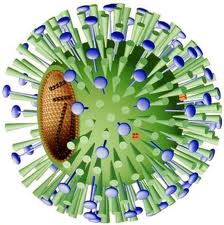In this blog we look at potential 21st century cures for two diseases that have plagued humanity each creating an unwarranted burden on society – one more economic than deadly, the other more frightening in its potential to take human life. Both derive from viral infections. The former disease is the common cold. The latter is influenza or flu.
The Common Cold
The common cold is associated with 200 virus types. These include rhinovirus of which there are 110 types, coronavirus, 30 types, and a smattering of others such as adenovirus (pictured below), coxsackievirus, echovirus, coxsackievirus, respiratory syncytial virus and enterovirus. Among cold viruses are some that cause even more serious illnesses. These include orthomyxovirus with strains associated with influenza, and paramyxovirus with its parainfluenza virus strains.
With so many cold viruses, developing a cure becomes a challenge. But recently researchers in Cambridge in the United Kingdom have made a discovery that could lead to a way to defeat cold viruses even after they have invaded cells.

To appreciate this discovery it is important to understand how viruses propagate and cause cold symptoms. Viruses cannot replicate by themselves. They need the machinery of the cells they invade to generate copies of themselves. Initially a cold virus is introduced to the body by penetrating through the mucus membranes in the nose and throat. The virus is small enough to slip through the mucus defence barrier. It binds with a surface receptor on cells lining the nose and throat and by doing so gets access to the protein-making machinery within the cell. Using the cell proteins the viruses replicate and rapidly invade nearby cells.
Virus-infected cells emit chemical signatures that attract the body’s immune system to them to fight off the invaders. It is the white cells in the immune system that cause an immune system response which includes the symptoms we associate with a cold: stuffy nose, mucus and phlegm, and the cough response to the irritation and inflammation of the nasal and respiratory membrane.
Colds normally don’t last very long, a few days and a few days going. After a week they are usually gone. But sometimes cold viruses leave the body susceptible to other infectious agents of a far more serious nature. So besides finding a way to defeat the cold for its own sake, there are other good reasons to come up with a cure.
Can We Cure It?
Detection and disruption represent the key strategies for curing the common cold. If our immune system could disrupt the virus before it harnesses the machinery of infected cells, the virus would be unable to replicate and would die. At the Laboratory of Molecular Biology, at Cambridge in the United Kingdom, researchers have discovered that anti-viral antibodies have the ability to ride piggyback on an invading virus as it enters the cell and to kill the virus before it replicates. Previously this had never been observed. Scientists thought antibodies only worked outside cells.
In making this discovery, researchers may be able to harness proteins within the cell to fight the virus. The principal antibody recognition cellular protein is tripartite motif-containing 21 or TRIM21. In a normal cold it takes several days before TRIM21 builds up in cells to fight off the viral invasion. But if a vaccine could boost the TRIM21 response by enhancing its fighting power it could neutralize the virus earlier, disrupting it within a few hours and before the infection leads to immune response symptoms.
The findings were recently published in the Journal Proceedings of the National Academy of Sciences. Before human clinical testing scientists will begin lab animal studies. It is expected that a human vaccine will be available before 2020.
This approach could lead to cures for many other disease caused by viruses including rotavirus and enterovirus, a group of viruses that infect millions of children annually resulting in hundreds of thousands of deaths.
Influenza
In 1918 with the World War coming to an end, a flu epidemic later called the Spanish Flu killed more people than the war it followed. Spanish Flu infected 20% of the world’s population over its two-year run and killed between 20 and 40 million. Those most susceptible were young adults between the ages 20 and 40.
Every year when flu season comes around we are encouraged to get a flu shot. Flu can be deadly and influenza viruses can jump species from animal to human hosts such as H1N1 known as Swine Flu. Where the animal may have acquired immunity over time, the human may not. Hence Swine Flu killed many young people who had no immunity to it, Bird Flu in Asia killed handlers of domestic fowl for the same reason, and SARS, a virus that originated in China and spread by airplane around the world, caused many deaths before isolation controls ended the pandemic.
Flu is very different from the common cold. Its onset is faster and the symptoms are more profound. It infects the respiratory tract from the nose to the lungs. It can in any single flu season, associated with late fall and winter months, infect as much as 20% of the population and kill thousands.
It is caused by three types of influenza viruses labelled A and B and C. C is the mildest and not associated with epidemics or pandemics. Type A influenza includes H1N1 or swine flu and along with Type B are associated with these large-scale outbreaks.

The influenza virus constantly evolves making it very difficult for biomedical researchers to develop infection controls to deal with the changes. Flu vaccines are formulated for the most part to fight last year’s influenza virus variant. Scientists in the Northern Hemisphere get a sneak peek at the next influenza virus when outbreaks occur in the Southern Hemisphere, a 6-month window to develop a vaccine that combines last year’s and the current influenza happening at the opposite side of the planet. The most recent flu pandemic occurred in 2009 with the H1N1 outbreak in Australasia before arriving in North America and Europe. H1N1 resulted in 57 million cases in the United States and 11,690 deaths.
Can We Do Better than the Annual Flu Shot?
The answer is yes and researchers at MIT’s Lincoln Laboratory may have found the answer. They call it DRACO for short. It stands for Double-stranded RNA Activated Caspase Oligomerizer, an antiviral therapy designed to find and kill virus-infected cells, leaving uninfected cells unharmed.
Rather than specifically targeting a single virus DRACO takes a broad-spectrum approach, targeting a type of RNA produced by virus-infected cells. DRACO as a therapeutic cure is not limited to treating influenza. It has the potential to deal with outbreaks of almost any virus.
Through animal studies, MIT researchers identified a form of RNA that only appeared in virus infected cells. Dubbed dsRNA, or double-stranded RNA, the cells natural defence systems attach a protein to the strand in an attempt to block it with the virus countering the cell’s defence every step of the way.
The researchers decided to combine one of these dsRNA-binding proteins with a more lethal protein, one that causes cellular death, known as apoptosis. Apoptosis occurs in cells naturally after many replications when telomeres shorten to the point that the protein initiates the cell’s demise. It also can initiate when a cell begins to exhibit cancerous behaviours.
Through DRACO therapy the naturally occurring apoptosis protein bound to the dsRNA protein can cross the cell membrane of any cells in the body. If no dsRNA is present DRACO leaves the cell unharmed. If dsRNA is present, DRACO initiates cell suicide. Mice treated with DRACO were completely free of viral infections with no toxic side effects. Clinical human trials are not too far in the future.








